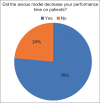Evaluation of the ex-vivo porcine simulator on EUS-guided cystogastrostomy using lumen-apposing metal stent training
- PMID: 35708369
- PMCID: PMC9258017
- DOI: 10.4103/EUS-D-21-00109
Evaluation of the ex-vivo porcine simulator on EUS-guided cystogastrostomy using lumen-apposing metal stent training
Abstract
Bckground and objectives: EUS-guided cystogastrostomy is a well-established advanced endoscopic technique with a steep-learning curve which necessitates an ex-vivo simulator that would allow for adequate training. The aim of this study is to evaluate the feasibility of the model in allowing training for EUS-guided cystogastrostomy using lumen-apposing metal stent (LAMS).
Subjects and methods: The model was created by ROEYA Training Center, Egypt, using native porcine tissue to create fluid collections simulating both cystic and solid lesions. It was designed and tested in advance while the hydrogel was added on-site. The simulator was evaluated prospectively in five training sessions involving 17 international experts. The task was to successfully deploy the LAMS to drain the created cyst. After using the simulator, the experts were asked to fill a questionnaire to assess their experience. The primary endpoint was overall satisfaction with the model as a training tool.
Results: All of the experts were satisfied with the model as a tool to train endoscopists for the technique. 76.5% (n = 11) of the experts thought the model to be moderately realistic. Proper visualization was reported by 94.1% of the experts. All experts believed the lesions to be either slightly like or very similar to real lesions. The model was graded "easy" in difficulty by 11 of the experts.
Conclusions: In all parameters assessed, the experts thought the model to be a useful tool for future training. This preliminary study suggests that the aforementioned simulator can be used to train endoscopists on using LAMS in a risk-free environment.
Keywords: EUS-guided drainage; cystogastrostomy; training model.
Conflict of interest statement
None
Figures











Similar articles
-
Lumen-apposing-metal stent misdeployment in endoscopic ultrasound-guided drainages: A systematic review focusing on issues and rescue management.World J Gastroenterol. 2023 Jun 7;29(21):3341-3361. doi: 10.3748/wjg.v29.i21.3341. World J Gastroenterol. 2023. PMID: 37377584 Free PMC article.
-
Experimental study of a physician-controlled electrocautery-enhanced delivery system incorporating a newly developed lumen-apposing metal stent for interventional endoscopic ultrasound (with videos).J Hepatobiliary Pancreat Sci. 2022 Jul;29(7):817-824. doi: 10.1002/jhbp.1113. Epub 2022 Jan 25. J Hepatobiliary Pancreat Sci. 2022. PMID: 35030302
-
Single Center Experience of Eus-Guided Cystogastrostomy and Lumen-Apposing Metal Stent (LAMS) Positioning in Children with Pancreatic Fluid Collections: A Case Series.Children (Basel). 2024 May 26;11(6):643. doi: 10.3390/children11060643. Children (Basel). 2024. PMID: 38929223 Free PMC article.
-
Feasibility, safety, and outcomes of a single-step endoscopic ultrasonography-guided drainage of pancreatic fluid collections without fluoroscopy using a novel electrocautery-enhanced lumen-apposing, self-expanding metal stent.Endosc Ultrasound. 2017 Mar-Apr;6(2):131-135. doi: 10.4103/2303-9027.204814. Endosc Ultrasound. 2017. PMID: 28440239 Free PMC article.
-
Lumen-apposing metal stents for malignant biliary obstruction: Is this the ultimate horizon of our experience?World J Gastroenterol. 2019 Aug 7;25(29):3857-3869. doi: 10.3748/wjg.v25.i29.3857. World J Gastroenterol. 2019. PMID: 31413524 Free PMC article. Review.
References
-
- Lerch MM, Stier A, Wahnschaffe U, et al. Pankreaspseudozysten: Abwarten, endoskopisch drainieren, resezieren? Dtsch Arztebl. 2009;106:614–21.
-
- Sarr MG, Banks PA, Bollen TL, et al. The new revised classification of acute pancreatitis 2012. Surg Clin North Am. 2013;93:549–62. - PubMed
-
- da Costa DW, Boerma D, van Santvoort HC, et al. Staged multidisciplinary step-up management for necrotizing pancreatitis. Br J Surg. 2014;101:e65–79. - PubMed

